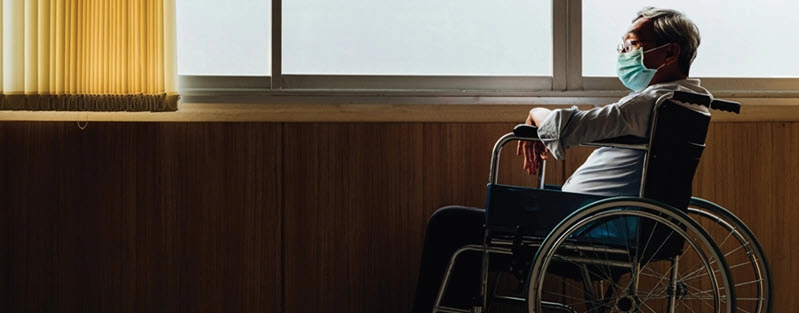Stay Up to Date on How COVID-19 is Affecting the Industry
Consider how the big picture news might play out on your facility’s operations. There’s a glimmer of hope visible, but we’re all still in a very long pandemic tunnel. With new variants of the virus, variable vaccination distribution and accessibility, and disagreement on basic safety precautions, the long-term care industry is still in the midst of a crisis. Know what the top infectious disease scientists are saying, and how newly available science may affect nursing home staff and residents. Note Pushback Against CDC on PPE More than a dozen prominent scientists wrote a letter to the Centers for Disease Control and Prevention (CDC) asking the agency to update its guidance on mask wearing. The signatories write that government agencies needs to acknowledge the ease with which the virus that causes COVID-19, SARS-CoV-2, is transmitted by the air. Right now, the CDC recommends reserving N95 respirators for healthcare workers who are performing “aerosol-generating” procedures. The signatories say the science demonstrates that healthcare workers are being sickened because the precautions they are taking — which are consistent with current CDC guidance — are inadequate. “CDC continues to recommend surgical masks for most healthcare workers and limits the use of NIOSH-certified respirators only to direct patient care or aerosol generating procedures with COVID-19 patients. It is now well documented that healthcare workers in non-COVID-19 patient care and support positions are also at high risk of infection and should be wearing respirators,” the signatories say. They also note that Black people and people of color have already suffered some of the highest rates of infection, and also constitute much of the “essential” workforce, which holds true for many people who work in the long-term care industry. The signatories suggest that the CDC updating its guidance to make sure all healthcare workers can access respirators would help keep healthcare workers and the general public safer — and minimize further illness and death from COVID-19 in communities that have already suffered greatly. “For reasons supported by science, comfort, costs, and practicality, CDC does not recommend the use of N95 respirators for protection against COVID-19 by the general public,” said Jason McDonald, spokesperson for the CDC. Although N95 and equivalent respirators were inaccessible earlier in the pandemic, at this point, there are millions of newly manufactured respirators awaiting purchase. The signatories suggest that employers are not utilizing the supply because many are “reluctant to buy from new producers or believing there is no need for their use.” The scientists feel strongly that workers can and should be better protected, even though these respirators are more expensive than the surgical masks currently recommended. Read the letter (and see the science cited) here www.cidrap.umn.edu/sites/default/files/public/downloads/immediate_action_to_address_inhalation_exposure_to_sars-cov-2_2142021.pdf. Look for New OSHA Standards In an executive order, President Joe Biden gave the Occupational Safety and Health Administration (OSHA) a deadline of March 15 to revise its standards to meet current scientific understanding of SARS-CoV-2. The agency is tasked with keeping workers safe by evaluating and enforcing workplace safety measures, and Biden has asked the agency to sharpen its focus on making sure workplaces are as safe as possible, with regard to COVID-19. One of the main tasks Biden issued to OSHA is deciding whether masks are temporarily necessary in workplaces. The letter writers mentioned earlier in this article include a challenge to this executive order, requiring OSHA to issue an emergency standard on COVID-19 that “recognizes the importance of aerosol inhalation, includes requirements to assess risks of exposure, and requires implementation of control measures following a hierarchy of controls. The standard should address requirements for effective respiratory protection for all healthcare and other workers at high risk of exposure to COVID-19.” What’s Going on With New York Nursing Homes? There is an increasingly politicized controversy about COVID-19 death data in New York nursing homes this spring. The New York Department of Health, part of the administration of New York Governor Andrew Cuomo, had issued an advisory for nursing homes in March 2020 that included this edict: “No resident shall be denied re-admission or admission to the NH solely based on a confirmed or suspected diagnosis of COVID-19. NHs are prohibited from requiring a hospitalized resident who is determined medically stable to be tested for COVID-19 prior to admission or readmission.” An investigation launched by the New York state attorney general, Letitia James, shows that the number of deaths of nursing home residents from COVID-19 was undercounted by approximately 50 percent. “As the pandemic and our investigations continue, it is imperative that we understand why the residents of nursing homes in New York unnecessarily suffered at such an alarming rate,” James said. The investigation shows a huge discrepancy in numbers, but also reflects the very real challenges facilities faced and continue to face: lack of staffing, lack of PPE, and lack of communication. James’ office also alleges that some for-profit facilities may have taken advantage of the state reimbursement model for nursing homes, which “gives a financial incentive to owners of for-profit nursing homes to transfer funds to related parties (ultimately increasing their own profit) instead of investing in higher levels of staffing and PPE.” Ultimately, workers on the ground and the residents they care for suffered and died, and various entities are trying to figure out who should be held accountable — and what changes can be made and enforced to keep everyone safe now and in the future.


